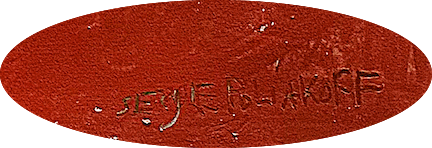

(Moscou, 1900 – Paris, 1969)

Serge Poliakoff, born in Moscow in 1900, painted one of the most significant artworks of Abstraction and Modern Art. In his childhood, his mother brought him to church almost every day. Poliakoff admired icons, their colours and their juxtaposition of space. His mother also forced him to practice an instrument and Poliakoff, at the age of twelve, perfectly mastered the guitar.
In 1914, Poliakoff entered the Moscow Drawing School. With the Russian Revolution in 1917, Poliakoff left Russia and arrived in Constantinople in 1920. This is where he started a period of recovered fullness, forgetting his Muscovites years. The future great painter played in orchestras and earned his living as a guitarist. With his quartet, his traveled around Europe: Belgrade, Sofia, Vienna and Berlin. Poliakoff arrived in Paris in 1923. He started to frequent the Russian artistic community and played in Russian cabarets. Playing guitar to earn his living, Poliakoff started to create abstract drawings, deciding to finally dedicate himself entirely to painting in 1929. He attended the Academy de la Grande Chaumière where he learned drawing. In 1935, he joined the French Artists Society and participated in their Salons in the painting section.
In his Self-portrait of 1933, we can notice a technical savoir-faire and a certain liberty with hatching. At this time, Poliakoff principally used Tempera which allowed him to create varied effects and thus play on opacity, transparency, and thickness, sometimes adding sand.
His paintings were still very academic, until his journey in London in 1935, where he discovered abstraction and lightness of colours. In London, Poliakoff continued his studies and regularly went to the British Museum where he discovered the colour superposition technique, a technique used to paint Egyptian sarcophagus. He became interested in Primitive Flemish, Gauguin, Seurat, Cezanne, or more contemporary, in Paul Klee.
In 1937, he returned to Paris and started his first researches on Abstraction. During this time, Poliakoff met Kandinsky who encouraged him in his desire to develop Abstraction internationally. Poliakoff then realised his first non-figurative paintings. In 1938, Poliakoff became friends with Robert and Sofia Delaunay, who introduced him to Otto Freundlich.
At this time, his first abstract paintings were exhibited. The gallery Le Niveau organised a collective exhibition with works of Derain, Utrillo, Lhote, Kisling, Braque, Dufy and Vlaminck. His abstract painting didn't stop him in realising figurative works, but his first abstract gouache of 1937 definitively created a new painting conception.
After the war, Poliakoff progressively elaborated his art, defined by colours and irregular forms. He was soon recognized as a major abstract painter of the Ecole de Paris. The painter gives a singular and unique version of Abstraction, far from a strict geometry and gestural improvisation.
Poliakoff participated at the Salon des Independents in 1940 and 1941. Between the two Salons, we can notice an evolution and a technical change, from a thick material to a most largely treatment. In the second exhibited painting, the perspective disappears, and all elements are on the same plan.
In Paris, after-war years were favourable in the development of art and artistic manifestations. Poliakoff multiplied his presence in collective exhibitions and salons, showing much abstraction. In 1946, he participated at the Salon des Surrindependents and showed a painting with a brilliant polychrome, recognized by critics. At this time, Poliakoff considered his painting to still be decorative. He attenuated his palette to the point of nearly monochrome. Lines or a dominant shade animated his compositions. The following year, he received the Kandinsky Prize, a prize that recompenses an abstract artist.
In 1948-1949, Poliakoff continued his technical and pictorial research, leading to “Absolute Silence”: the vertical line is moving and the horizontal line is traced on a demi-circular horizon. Even pushing on abstraction, nature isn’t forgoton in his painting: “Our eye is our judge, my master is the nature”. It always intervenes but as a foundation of a horizon perception.
Between 1946 and 1952, Poliakoff multiplied his plastic experimentations. The line underlines a certain form with a discreet paintbrush. It is not the form that is coloured, but the colour which produces its own form. Poliakoff gave a new conception of nature during this time. He affirmed his singularity as a painter of the Ecole de Paris. His style gave him a growing reputation, especially with collective and personal exhibitions. He acquired an international reputation thanks to the art dealer Denise René who organised exhibitions in Europe. The gallery L’Esquisse organised a solo show that is a veritable revelation for public and critic.
In 1951, Poliakoff participated in exhibitions organised by the Royal Academy in London dedicated to Ecole de Paris.
In 1962, the Venice Biennale dedicated a entire room to his paintings. In 1965, the fashion designer Yves Saint-Laurent signed a Mondrian Dress and a Poliakoff Dress.
In 1970, the Museum of Modern Art in Paris organised a first exhibition for the abstract painter, and an important retrospective in 2013 with no less than 150 of his paintings made between 1946 and 1967.